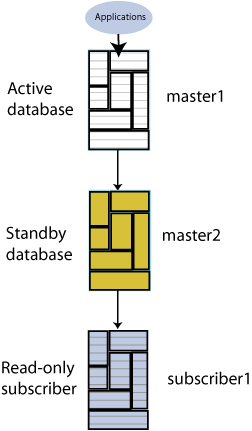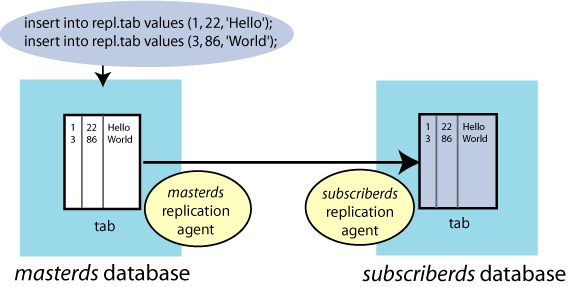| Oracle® TimesTen In-Memory Database Replication Guide 11g Release 2 (11.2.2) Part Number E21635-04 |
|
|
PDF · Mobi · ePub |
| Oracle® TimesTen In-Memory Database Replication Guide 11g Release 2 (11.2.2) Part Number E21635-04 |
|
|
PDF · Mobi · ePub |
This chapter describes how to configure and start up sample replication schemes. It includes these topics:
You must have the ADMIN privilege to complete the procedures in this chapter.
This section describes how to create an active standby pair with one subscriber. The active database is master1. The standby database is master2. The subscriber database is subscriber1. To keep the example simple, all databases reside on the same computer, server1.
Figure 2-1 shows this configuration.
Figure 2-1 Active standby pair with one subscriber

This section includes the following topics:
Step 1: Create the DSNs for the master and the subscriber databases
Step 7: Duplicate the active database to the standby database
Create DSNs named master1, master2 and subscriber1 as described in "Managing TimesTen Databases" in Oracle TimesTen In-Memory Database Operations Guide.
On UNIX systems, use a text editor to create the following odbc.ini file:
[master1] DRIVER=install_dir/lib/libtten.so DataStore=/tmp/master1 DatabaseCharacterSet=AL32UTF8 ConnectionCharacterSet=AL32UTF8 [master2] DRIVER=install_dir/lib/libtten.so DataStore=/tmp/master2 DatabaseCharacterSet=AL32UTF8 ConnectionCharacterSet=AL32UTF8 [subscriber1] DRIVER=install_dir/lib/libtten.so DataStore=/tmp/subscriber1 DatabaseCharacterSet=AL32UTF8 ConnectionCharacterSet=AL32UTF8
On Windows, use the ODBC Administrator to set the same connection attributes. Use defaults for all other settings.
Use the ttIsql utility to connect to the master1 database:
% ttIsql master1 Copyright (c) 1996-2011, Oracle. All rights reserved. Type ? or "help" for help, type "exit" to quit ttIsql. connect "DSN=master1"; Connection successful: DSN=master1;UID=terry;DataStore=/tmp/master1; DatabaseCharacterSet=AL32UTF8;ConnectionCharacterSet=AL32UTF8;TypeMode=0; (Default setting AutoCommit=1) Command>
Create a table called tab with columns a and b:
Command> CREATE TABLE tab (a NUMBER NOT NULL,
> b CHAR(18),
> PRIMARY KEY (a));
Define the active standby pair on master1:
Command> CREATE ACTIVE STANDBY PAIR master1, master2
> SUBSCRIBER subscriber1;
For more information about defining an active standby pair, see Chapter 3, "Defining an Active Standby Pair Replication Scheme".
Start the replication agent on master1:
Command> CALL ttRepStart;
The state of a new database in an active standby pair is 'IDLE' until the active database has been set.
Use the ttRepStateSet built-in procedure to designate master1 as the active database:
Command> CALL ttRepStateSet('ACTIVE');
Verify the state of master1:
Command> CALL ttRepStateGet; < ACTIVE, NO GRID > 1 row found.
Create a user terry with a password of terry and grant terry the ADMIN privilege. Creating a user with the ADMIN privilege is required by Access Control for the next step.
Command> CREATE USER terry IDENTIFIED BY terry; User created. Command> GRANT admin TO terry;
Exit ttIsql and use the ttRepAdmin utility with the -duplicate option to duplicate the active database to the standby database. If you are using two different hosts, enter the ttRepAdmin command from the target host.
% ttRepAdmin -duplicate -from master1 -host server1 -uid terry -pwd terry "dsn=master2"
Use ttIsql to connect to master2 and start the replication agent:
% ttIsql master2 Copyright (c) 1996-2011, Oracle. All rights reserved. Type ? or "help" for help, type "exit" to quit ttIsql. connect "DSN=master2"; Connection successful: DSN=master2;UID=terry;DataStore=/tmp/master2; DatabaseCharacterSet=AL32UTF8;ConnectionCharacterSet=AL32UTF8;TypeMode=0; (Default setting AutoCommit=1) Command> CALL ttRepStart;
Starting the replication agent for the standby database automatically sets its state to 'STANDBY'. Verify the state of master2:
Command> CALL ttRepStateGet; < STANDBY, NO GRID > 1 row found.
Use the ttRepAdmin utility to duplicate the standby database to the subscriber database:
% ttRepAdmin -duplicate -from master2 -host server1 -uid terry -pwd terry "dsn=subscriber1"
Use ttIsql to connect to subscriber1 and start the replication agent. Verify the state of subscriber1.
% ttIsql subscriber1 Copyright (c) 1996-2011, Oracle. All rights reserved. Type ? or "help" for help, type "exit" to quit ttIsql. connect "DSN=subscriber1"; Connection successful: DSN=subscriber1;UID=terry;DataStore=/stmp/subscriber1; DatabaseCharacterSet=AL32UTF8;ConnectionCharacterSet=AL32UTF8;TypeMode=0; (Default setting AutoCommit=1) Command> CALL ttRepStart; Command> call ttRepStateGet; < IDLE, NO GRID > 1 row found.
Insert a row into the tab table on master1.
Command> INSERT INTO tab VALUES (1,'Hello'); 1 row inserted. Command> SELECT * FROM tab; < 1, Hello > 1 row found.
Verify that the insert is replicated to master2 and subscriber1.
Command> SELECT * FROM tab; < 1, Hello > 1 row found.
Stop the replication agents on each database:
Command> CALL ttRepStop;
Drop the active standby pair on each database. You can then drop the table tab on any database in which you have dropped the active standby pair.
Command> DROP ACTIVE STANDBY PAIR;
Command> DROP TABLE tab;
This section describes how to configure a replication scheme that replicates the contents of a single table in a master database (masterds) to a table in a subscriber database (subscriberds). To keep the example simple, both databases reside on the same computer.
This section includes the following topics:
Step 2: Create a table and replication scheme on the master database
Step 3: Create a table and replication scheme on the subscriber database
Create DSNs named masterds and subscriberds as described in "Managing TimesTen Databases" in Oracle TimesTen In-Memory Database Operations Guide.
On UNIX systems, use a text editor to create the following odbc.ini file on each database:
[masterds] DataStore=/tmp/masterds DatabaseCharacterSet=AL32UTF8 ConnectionCharacterSet=AL32UTF8 [subscriberds] DataStore=/tmp/subscriberds DatabaseCharacterSet=AL32UTF8 ConnectionCharacterSet=AL32UTF8
On Windows, use the ODBC Administrator to set the same connection attributes. Use defaults for all other settings.
Connect to masterds with the ttIsql utility:
% ttIsql masterds Copyright (c) 1996-2011, Oracle. All rights reserved. Type ? or "help" for help, type "exit" to quit ttIsql. connect "DSN=masterds"; Connection successful: DSN=masterds;UID=ttuser; DataStore=/tmp/masterds;DatabaseCharacterSet=AL32UTF8; ConnectionCharacterSet=AL32UTF8;TypeMode=0; (Default setting AutoCommit=1) Command>
Create a table named tab with columns named a, b and c:
Command> CREATE TABLE tab (a NUMBER NOT NULL,
> b NUMBER,
> c CHAR(8),
> PRIMARY KEY (a));
Create a replication scheme called repscheme to replicate the tab table from masterds to subscriberds.
Command> CREATE REPLICATION repscheme
> ELEMENT e TABLE tab
> MASTER masterds
> SUBSCRIBER subscriberds;
Connect to subscriberds and create the same table and replication scheme, using the same procedure described in Step 2.
Start the replication agents on masterds and subscriberds:
Command> call ttRepStart;
Exit ttIsql. Use the ttStatus utility to verify that the replication agents are running for both databases:
% ttStatus TimesTen status report as of Thu Aug 11 17:05:23 2011 Daemon pid 18373 port 4134 instance ttuser TimesTen server pid 18381 started on port 4136 ------------------------------------------------------------------------ Data store /tmp/masterds There are 16 connections to the data store Shared Memory KEY 0x0201ab43 ID 5242889 PL/SQL Memory KEY 0x0301ab43 ID 5275658 Address 0x10000000 Type PID Context Connection Name ConnID Process 20564 0x081338c0 masterds 1 Replication 20676 0x08996738 LOGFORCE 5 Replication 20676 0x089b69a0 REPHOLD 2 Replication 20676 0x08a11a58 FAILOVER 3 Replication 20676 0x08a7cd70 REPLISTENER 4 Replication 20676 0x08ad7e28 TRANSMITTER 6 Subdaemon 18379 0x080a11f0 Manager 2032 Subdaemon 18379 0x080fe258 Rollback 2033 Subdaemon 18379 0x081cb818 Checkpoint 2036 Subdaemon 18379 0x081e6940 Log Marker 2035 Subdaemon 18379 0x08261e70 Deadlock Detector 2038 Subdaemon 18379 0xae100470 AsyncMV 2040 Subdaemon 18379 0xae11b508 HistGC 2041 Subdaemon 18379 0xae300470 Aging 2039 Subdaemon 18379 0xae500470 Flusher 2034 Subdaemon 18379 0xae55b738 Monitor 2037 Replication policy : Manual Replication agent is running. Cache Agent policy : Manual PL/SQL enabled. ------------------------------------------------------------------------ Data store /tmp/subscriberds There are 16 connections to the data store Shared Memory KEY 0x0201ab41 ID 5177351 PL/SQL Memory KEY 0x0301ab41 ID 5210120 Address 0x10000000 Type PID Context Connection Name ConnID Process 20594 0x081338f8 subscriberds 1 Replication 20691 0x0893c550 LOGFORCE 5 Replication 20691 0x089b6978 REPHOLD 2 Replication 20691 0x08a11a30 FAILOVER 3 Replication 20691 0x08a6cae8 REPLISTENER 4 Replication 20691 0x08ad7ba8 RECEIVER 6 Subdaemon 18376 0x080b1450 Manager 2032 Subdaemon 18376 0x0810e4a8 Rollback 2033 Subdaemon 18376 0x081cb8b0 Flusher 2034 Subdaemon 18376 0x08246de0 Monitor 2035 Subdaemon 18376 0x082a20a8 Deadlock Detector 2036 Subdaemon 18376 0x082fd370 Checkpoint 2037 Subdaemon 18376 0x08358638 Aging 2038 Subdaemon 18376 0x083b3900 Log Marker 2040 Subdaemon 18376 0x083ce998 AsyncMV 2039 Subdaemon 18376 0x08469e90 HistGC 2041 Replication policy : Manual Replication agent is running. Cache Agent policy : Manual PL/SQL enabled.
Use ttIsql to connect to the master database and insert some rows into the tab table:
% ttIsql masterds Command> INSERT INTO tab VALUES (1, 22, 'Hello'); 1 row inserted. Command> INSERT INTO tab VALUES (3, 86, 'World'); 1 row inserted.
Open a second command prompt window for the subscriber. Connect to the subscriber database and check the contents of the tab table:
% ttIsql subscriberds Command> SELECT * FROM tab; < 1, 22, Hello> < 3, 86, World> 2 rows found.
Figure 2-3 shows that the rows that are inserted into masterds are replicated to subscriberds.
Figure 2-3 Replicating changes to the subscriber database

After you have completed your replication tests, stop the replication agents on both masterds and subscriberds:
Command> CALL ttRepStop;
To remove the tab table and repscheme replication scheme from the master and subscriber databases, enter these statements on each database:
Command> DROP REPLICATION repscheme; Command> DROP TABLE tab;